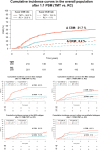Cancer-Specific Survival of Trimodal Therapy Versus Radical Cystectomy in T2N0M0 Non-Urothelial Bladder Cancer
- PMID: 40511689
- PMCID: PMC12311402
- DOI: 10.1002/jso.70014
Cancer-Specific Survival of Trimodal Therapy Versus Radical Cystectomy in T2N0M0 Non-Urothelial Bladder Cancer
Abstract
Introduction: We hypothesized that, within organ-confined (OC, T2N0M0) non-urothelial carcinoma of urinary bladder (non-UCUB) patients, trimodal therapy (TMT) use does not differ from radical cystectomy (RC) regarding cancer control outcomes.
Methods: Within the SEER database (2004-2021), rates of TMT versus RC use in OC non-UCUB patients were calculated. Nearest-neighbor 1:1 propensity score matching (PSM) for age, sex, race/ethnicity, and histological subtype was applied. Cumulative incidence plots depicted 5-year cancer-specific (CSM) and other-cause mortality (OCM) rates. Multivariable competing risks regression (CRR) models were fitted. Sensitivity analyses were performed within squamous cell (SCC), neuroendocrine (NEC), and adenocarcinoma (ADK) and other histological subtypes.
Results: Of 814 OC non-UCUB patients, 310 (38%) received TMT versus 504 (62%) RC. After PSM, 5-year CSM rate was 50% after TMT versus 29% after RC and TMT was associated with 2.1-fold higher CSM relative to RC (multivariable HR [mHR]: 2.1, p < 0.001). In sensitivity analyses within 229 (28%) SCC, TMT patients had higher 5-year CSM rates relative to their RC-counterparts (67% vs. 22%, mHR: 4.3, p < 0.001). Similarly, within 314 (39%) NEC, TMT patients had higher 5-year CSM rates relative to their RC-counterparts (mHR: 1.8, p < 0.001). Conversely, within 118 (28%) ADK and 153 (19%) other subtypes, CSM after TMT did not differ from CSM after RC (33% vs. 15%, mHR: 1.4 and 43% vs. 33%, mHR: 1.4; p = 0.4).
Conclusion: In OC non-UCUB patients TMT is associated with significantly higher CSM than RC. Most pronounced survival disadvantage was recorded within SCC and NEC patients.
Keywords: bladder cancer; non‐urothelial; radical cystectomy; subtypes; trimodal therapy.
© 2025 The Author(s). Journal of Surgical Oncology published by Wiley Periodicals LLC.
Conflict of interest statement
The authors declare no conflicts of interest.
Figures



Similar articles
-
Survival Outcomes and Temporal Trends of Non-Surgical Management Vs Radical Cystectomy in Non-Organ-Confined Urothelial Bladder Cancer.Urology. 2025 Jun;200:107-113. doi: 10.1016/j.urology.2025.02.051. Epub 2025 Mar 6. Urology. 2025. PMID: 40057122
-
Cancer-Specific Mortality of Partial Cystectomy Versus Radical Cystectomy in T2N0M0 Urothelial Bladder Cancer.Ann Surg Oncol. 2025 Aug;32(8):6133-6140. doi: 10.1245/s10434-025-17488-2. Epub 2025 May 27. Ann Surg Oncol. 2025. PMID: 40425913
-
Survival after trimodal therapy in octogenarians with organ-confined urothelial bladder cancer.BJU Int. 2025 May;135(5):828-834. doi: 10.1111/bju.16622. Epub 2024 Dec 12. BJU Int. 2025. PMID: 39667393 Free PMC article.
-
A systematic review and meta-analysis on the oncological long-term outcomes after trimodality therapy and radical cystectomy with or without neoadjuvant chemotherapy for muscle-invasive bladder cancer.Urol Oncol. 2018 Feb;36(2):43-53. doi: 10.1016/j.urolonc.2017.10.002. Epub 2017 Nov 6. Urol Oncol. 2018. PMID: 29102254
-
Oncological effectiveness of bladder-preserving trimodal therapy versus radical cystectomy for the treatment of muscle-invasive bladder cancer: a system review and meta-analysis.World J Surg Oncol. 2023 Aug 29;21(1):271. doi: 10.1186/s12957-023-03161-z. World J Surg Oncol. 2023. PMID: 37641150 Free PMC article.
References
-
- Aragon‐Ching J. B. and Pagliaro L. C., “New Developments and Challenges in Rare Genitourinary Tumors: Non‐Urothelial Bladder Cancers and Squamous Cell Cancers of the Penis,” in American Society of Clinical Oncology Educational Book (American Society of Clinical Oncology, Inc, 2017), 330–336, 10.1200/EDBK_175558. - DOI - PubMed
Publication types
MeSH terms
Grants and funding
LinkOut - more resources
Full Text Sources
Medical
Research Materials
Miscellaneous

